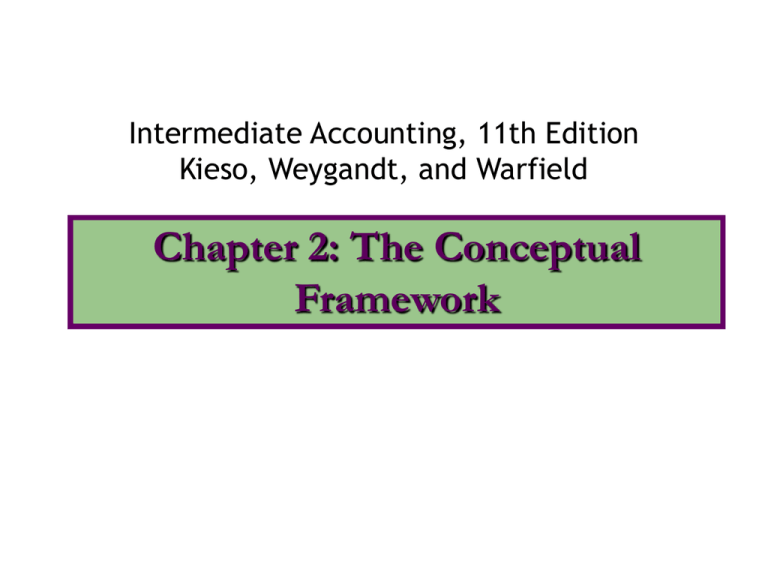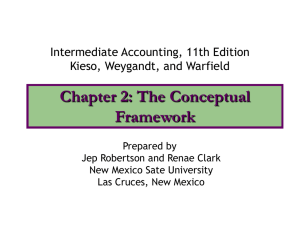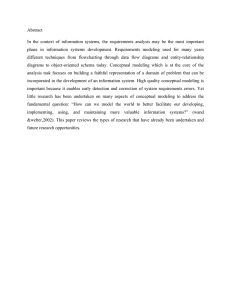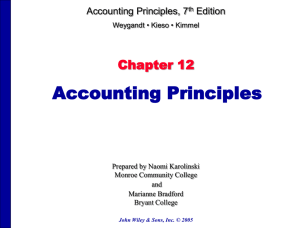
Intermediate Accounting, 11th Edition
Kieso, Weygandt, and Warfield
Chapter 2: The Conceptual
Framework
Chapter 2: The Conceptual
Framework
After studying this chapter, you should be able
to:
1. Describe the usefulness of a conceptual
framework.
2. Describe the FASB's efforts to construct a
conceptual framework.
3. Understand the objectives of financial
reporting.
4. Identify the qualitative characteristics of
accounting information.
Chapter 2: The Conceptual
Framework
5. Define the basic elements of financial
statements.
6. Describe the basic assumptions of accounting.
7. Explain the application of the basic principles
of accounting.
8. Describe the impact that constraints have on
reporting accounting information.
Objectives of the Conceptual
Framework
• The Framework was to be the
foundation for building a set of
coherent accounting standards and
rules.
• The Framework is to be a reference of
basic accounting theory for solving
emerging practical problems of
reporting.
Statements of Financial
Accounting Concepts
• The FASB has issued seven Statements of
Financial Accounting Concepts (SFACs) to
date (Statements 1 through 7.)
• These statements set forth major
recognition and reporting issues.
• Statement 4 pertains to reporting by nonbusiness entities.
• The other six statements pertain to
reporting by business enterprises.
Statements of Financial
Accounting Concepts
Statement
• Statement 1
• Statement 2
• Statement 6
• Statement 4
• Statement 5
• Statement 7
Brief Title
• Objectives of Financial
Reporting (Business)
• Qualitative
Characteristics
• Elements of Financial
Statements (replaces 3)
• Objectives of Financial
Reporting (Non-business)
• Recognition and
Measurement Criteria
• Using Cash Flows
Overview of the Conceptual
Framework
The Framework has three different
levels,comprised of:
• The first level consists of objectives.
• The second level explains financial elements
and characteristics of information.
• The third level incorporates recognition and
measurement criteria.
Conceptual Framework for
Financial Reporting
Basic Objectives of Financial
Reporting
To provide information:
• about economic resources, the claims on
those resources and changes in them.
• that is useful to those making investment
and credit decisions.
• that is useful to present and future
investors, creditors in assessing future cash
flows.
• to individuals who reasonably understand
business and economic activities.
Hierarchy of Accounting Qualities
Qualitative Characteristics of
Accounting Information
• Primary qualities of accounting information
are relevance and reliability.
• Secondary qualities are comparability and
consistency of reported information.
Primary Characteristic of
Accounting Information:
Relevance
“Relevance of information means information
capable of making a difference in a decision
context.”
Ingredients of relevant information are:
• Timeliness
• Predictive value
• Feedback value
Primary Characteristic of
Accounting Information:
Relevance
Information is reliable when it can be relied on
to represent the true, underlying situation.
The ingredients of reliable information are:
• verifiability
• representational faithfulness
• neutrality (unbiased)
Secondary Characteristics of
Accounting Information
Comparability: the similar measurement and
reporting for different enterprises.
Consistency: application of the same
accounting treatment to similar events by an
enterprise period to period.
Basic Elements of Financial
Statements
•
•
•
•
Assets
Liabilities
Equity
Investment by
Owners
• Distributions
to Owners
• Comprehensive
Income
• Revenues
• Expenses
• Gains
• Losses
Recognition and Measurement
Criteria
Basic
Assumptions
1. Economic
entity
2. Going
concern
3. Monetary
unit
4. Periodicity
Principles
1. Historical
cost
2. Revenue
recognition
3. Matching
4. Full
disclosure
Constraints
1. Cost benefit
2. Materiality
3. Industry
practices
4. Conservatism
COPYRIGHT
Copyright © 2004 John Wiley & Sons, Inc. All rights reserved.
Reproduction or translation of this work beyond that permitted
in Section 117 of the 1976 United States Copyright Act without
the express written permission of the copyright owner is
unlawful. Request for further information should be addressed
to the Permissions Department, John Wiley & Sons, Inc. The
purchaser may make back-up copies for his/her own use only
and not for distribution or resale. The Publisher assumes no
responsibility for errors, omissions, or damages, caused by the
use of these programs or from the use of the information
contained herein.








